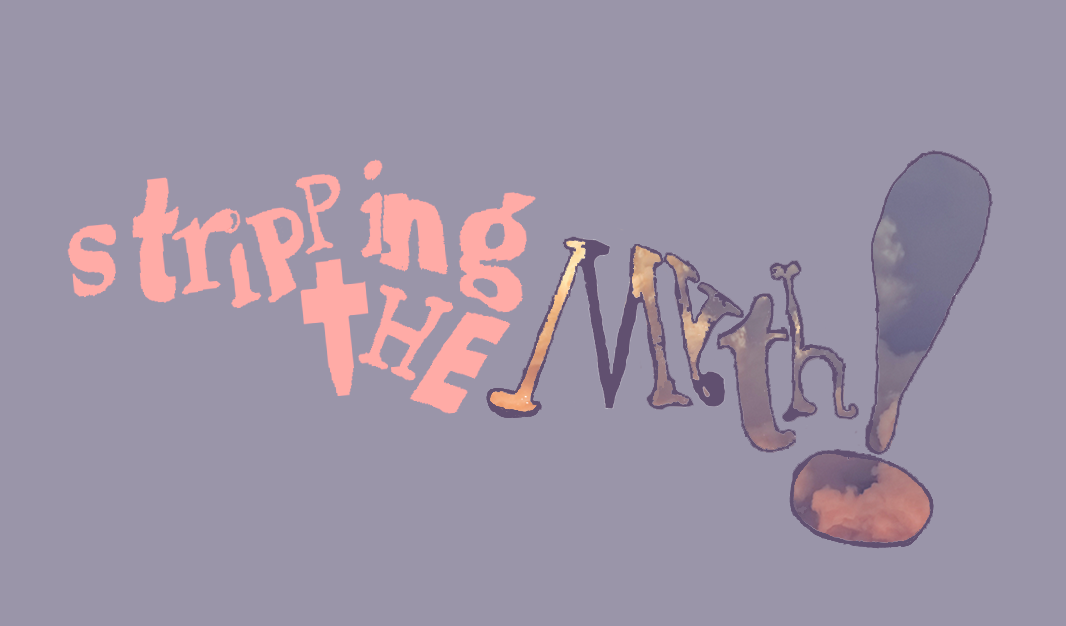Roll up, roll up, and welcome to our brand-new series ‘Stripping the Myth’! Here, we will be exploring all things sticky and sexy, shunned and shamed, embarking on a journey of discovery through the deconstructing and de-bunking of sex myths.

Stripping the Myth: Masturbation
Masturbating, wanking, jerking-off, choking the chicken, orbiting Venus, shaking hands with the milkman. Whatever you might call it, the act of sexual self-pleasure is ubiquitously enjoyed across every culture, age range, race, and gender.
Yet despite being a distinctly pleasurable and common expression of sexuality, masturbation remains a highly stigmatised topic in our society, particularly where it pertains to female and queer sexualities. Shrouded in myth and taboo, masturbation exists as a whispered secret, a shameful decree relegated to the realm of adolescent curiosity and hedonistic disgrace.
“Masturbation” comes from the Latin, “manus” meaning hand and “stupratio” meaning defilement. While we don’t necessarily relate it to its original defilement origins nowadays, masturbation is still often seen as something negative or immoral. It’s often portrayed or omitted from popular culture, academia, and art. To this day, masturbation is surrounded by myths, shame, and false portrayals.
Exploring some of the most common myths and misconceptions around masturbation, we invite you to join us here in reconceptualising masturbation, destigmatising sexual taboo, and in reclaiming sexual self-stimulation as an act of power rather than an act of shame.
Myth 1: Only Men Masturbate
Fact: Everyone Masturbates
Through a historical chastening of the sexual female body, and tasteless tropes that imply that ‘women don’t wank’, there exists a widespread misconception that the act of masturbation is reserved for people with penises.
This, simply, is not true!
Recent research has revealed that contrary to this popular belief, the majority of people with vulvas do in fact masturbate just as often, if not more than people with penises. The assumed percentage of those with vulvas who indulge in the act of self-pleasure on a frequent basis is estimated at at least 85% of the UK population – though likely more! – (Rowland, 2020).
The moralistic underpinnings of this gendered and sexed divide remain constant and unrelenting, stemming from the misogynistic sexual history that makes up our cultural understanding of sex itself. Through a positioning of the female body as “unmentionable” and infantilised, people with vulvas remain unaware of the language used to describe their own anatomy, the word “vagina” colloquially used to describe everything “down there”. The clitoris as ‘mystery’, in particular, positions the female body as a threat to the phallocentric sexual backdrop of our society.
Yet with an organ made up of over 8,000 nerve endings, a portal to pure sexual pleasure, the act of masturbation is nonetheless unsurprisingly enjoyed by people with clitorises across the globe.
Myth 2: Sex Toys are Harmful
Fact: Sex Toys are FUN
The use of sex toys outwith the medical realm has enabled us to, quite literally, take pleasure into our own hands. Sex toys have entered both private and partnered sex lives and have revolutionised the sex lives of many.
Yet despite their increasing popularity, sex toys remain to hold a strong social taboo. Where the vibrator and the dildo are concerned (toys generally associated with vaginal and clitoral stimulation) sex toys are widely understood as functioning as a threat in heteronormative relationships. Phallic in shape and usage, the dildo especially is depicted as a dangerous competitor that poses a threat of “harm” to heterosexual relationships.
Despite the emphasis on solo male masturbation in the UK, heterosexual men are the group least likely to purchase sex toys. Indeed, where the laddish decree for ‘jerking off’ is widespread, the English language distinctly sanctions male masturbation as inimical and adverse. “Wanker”; “Tosser”; “Jerk-Off”: some of our most popular swear words, all stem from male masturbation. The association then for many men, with sex toy usage, whether partnered or solo, is that of threat and shame.
The notion that toys are dirty or hold some association with sexual ill-health is also fictitious. Recent research building on a study from the Kinsey Institute has shown that those who regularly use vibrators are also more likely to engage in sexual health-promoting behaviours such as STI-tests and/or proper use of contraceptives, displaying that there is a strong association between sex toy usage and sexual wellness (Evans, 2020).
Where incorrect use of sex toys (e.g. poor hygiene and/or the use of unprotected sex toys with more than one partner) can, of course, lead to sexual ill-health, sex toys are easy to clean and care for, and where used properly, can actually promote healthy sex lives rather than problematising them. Unscented soap and water (thoroughly rinsed) is all you need! And if you are using lube when you play, make sure it’s water based!
A quick list of things NOT to use as sex toys:
- Fruits and vegetables.
As tempting (and cheap) as it might be, cucumbers/bananas or aubergines are *not* designed to go inside of your body. Whereas sex toys are generally pretty resilient, food breaks apart… and nobody wants to be stuck at the hospital picking bits of fruit out of their genitals.
- An electric toothbrush
We’ve all thought about it at one point or another.. but those fun vibrating bristles are likely to cause irritation or even microabrasions to your clitoral hood (ouch!)
Cleaning your teeth after a masturbation session also won’t be much fun. The cheapest vibrators are on the market for as little as £5 these days, working out as maybe even cheaper than the cheapest electric toothbrush.
- Anal toys without a flared base
Before you go diving into anal play, make sure you choose a toy with a flared base. The anus is a powerful muscle… If there isn’t a flared base to catch it, you run the risk of it slipping further in than you planned!
This same rule can apply to vaginal toys, but it’s much more rare for toys to get stuck in the vagina than in the anus.
- Dirty hands/re-used anal toys
Believe it or not, dirty fingernails are the number one cause of bacterial infections in your vulva. Where it might seem like fingering is the easiest way to ‘get yourself off’ without the use of other fun props, make sure to wash your hands first!
If you are experimenting with anal and vaginal play, or sharing toys with a partner/partners, make sure to thoroughly wash your toys in between and/or cover your toys with a condom, as STIs can be transmitted via improper toy use.
Myth 3: Masturbation Causes Health Problems
Fact: Masturbation is Good for You
Consider masturbation as a self-care routine that allows you to understand your body and to make yourself feel good. Releasing endorphins and dopamine, masturbation can reduce stress and anxiety, strengthen pelvic floor muscles, help prevent erectile dysfunction, and improve sexual function. Masturbating can also function as a natural pain-relief by combatting migraine pain, headaches and menstrual cramps.
Self-pleasure also affords us all an exploration of sexual self-confidence and empowerment, allowing us to better understand our bodies wants, needs, desires, likes and dislikes and communicate these to others who we might engage in intimacy with.
Myth 4: It’s Only for Singles
Fact: Masturbation is for Everyone
Relationship status doesn’t dictate whether you can or should masturbate. Regardless of whether you’re single or in a relationship (or relationships!), masturbation is a personal choice. In fact, it can be a valuable tool for understanding your own body, which can enhance intimacy in relationships and enable us to better communicate our own boundaries, needs and wants.
Masturbation – especially where porn consumption is involved – is often misconstrued as a form of cheating. In reality, however, many people use porn as a mere stimulus to invoke arousal, and masturbation is not a form of cheating. In fact, masturbation can function as an exciting way to explore with your partner. Perhaps you can explain to your partner(s) what you were aroused by in your last self-pleasure session, or even watch your favourite porn together!
Mutual masturbation can also be a fun way to explore sex with your partner(s) in a way that allows them to understand how you sexually satisfy yourself and can be an enjoyable way to experience sex together, without necessarily engaging in physical touch with each other. For some neurodivergent people, this can even help in finding a way to explore intimacy when feeling overstimulated physically by another person’s touch.
Crucially, masturbation is nothing to be ashamed of. Autoeroticism can be a fun, healthy, safe and exploratory experience that enables you to learn and grow with your own body (and with others!). Shrouded in myth and stigma, it might be difficult to talk to others openly about masturbating but it is nonetheless crucial that we understand that sexual self-stimulation is a natural part of human sexuality than can, will, and should be enjoyed by everybody (who wants to).
It’s also perfectly okay if you don’t masturbate, or that isn’t exciting to you. Human sexuality is a spectrum, and every body is a different body with their own individual needs, wants, and desires.
Sources:
- Evans, Samantha, ‘Can Using a Sex Toy Really Improve your Sexual Health?’, Contemporary Institute of Clinical Sexology, (July 8th, 2020), https://www.theinstituteofsexology.org/blog/sex-toy-improve-sexual-health
- Rowland, David L., ‘Why and How Women Masturbate, and the Relationship to Orgasmic Response’ Sex and Marital Therapy, Vol. 46, No. 4 (2020), https://www.tandfonline.com/doi/full/10.1080/0092623X.2020.1717700?needAccess=true






Leave a Comment